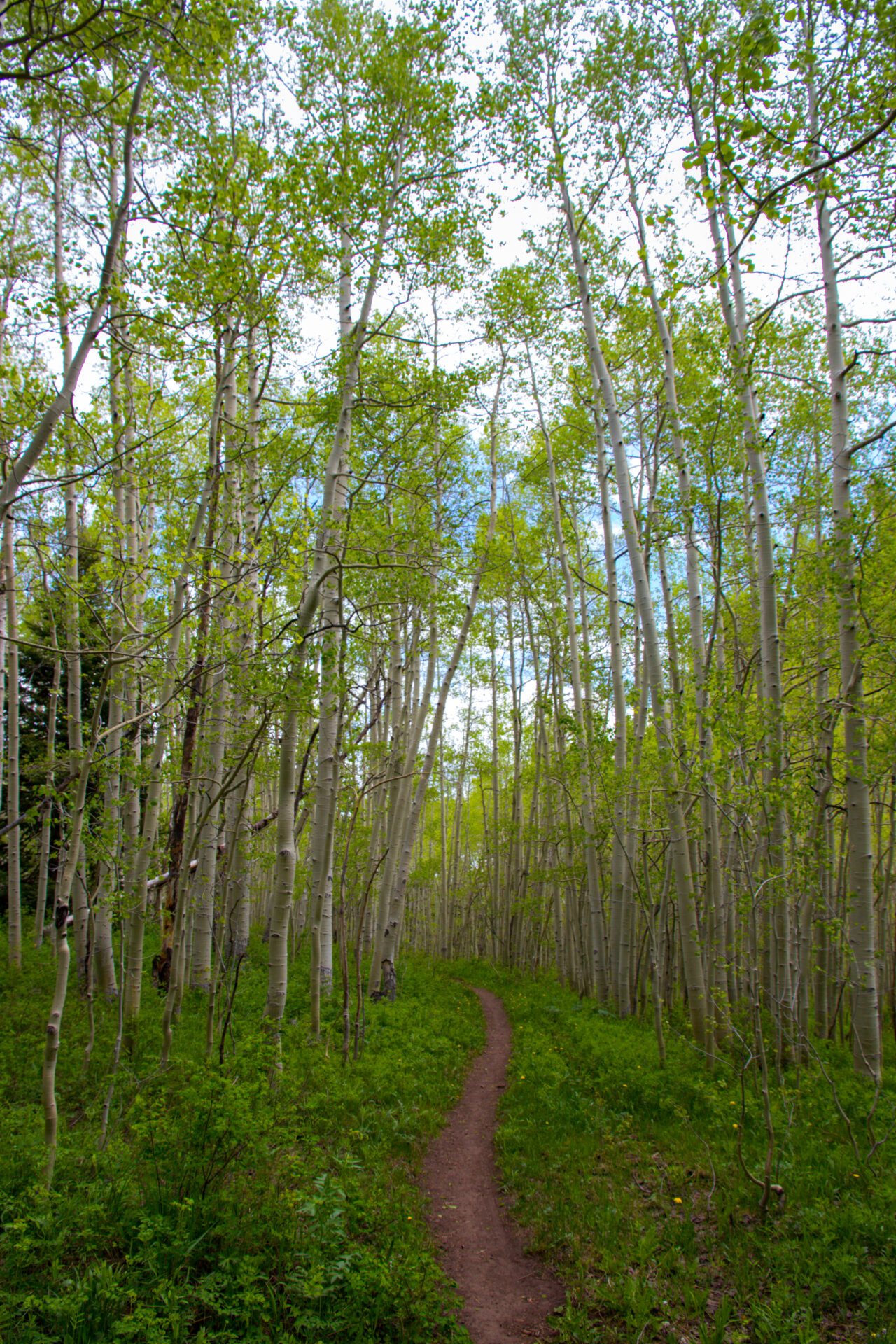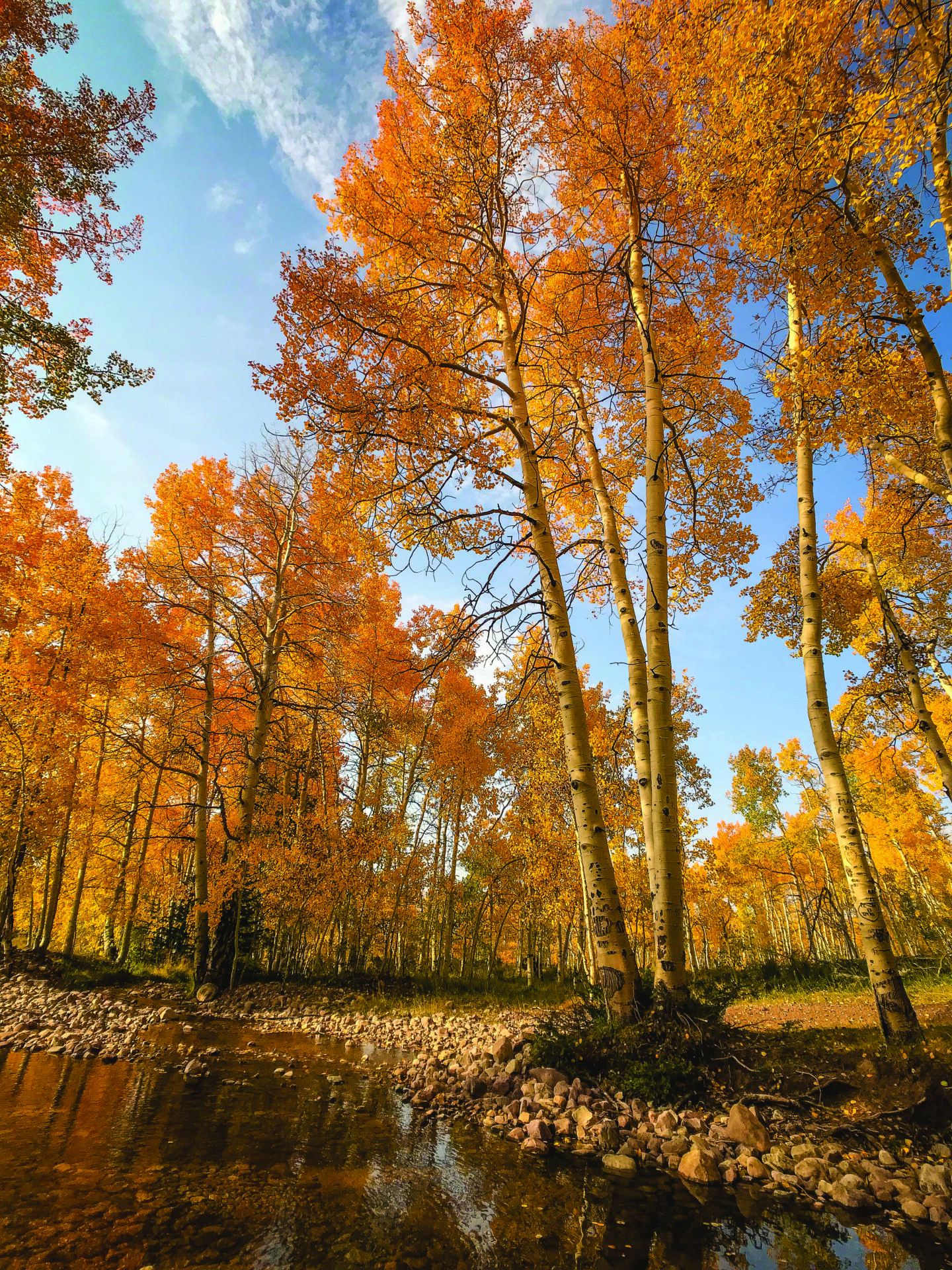This article was originally published in the Fall 2022 issue of Covered Bridge’s sister publication, Spoke+Blossom.
We can all be traced back somewhere, to a parent, family … some may say roots. Though we have somewhat of a genetic predisposed path in one form or another, the factors of our environment are truly what our growth depends on. Most people think of a family tree as what happens above ground, but it actually occurs out of sight, below the surface.
Aspens are commonly known for their warm-toned leaves and white trunk. What most people aren’t aware of are the unique characteristics of their reproduction cycle. Aspen’s could be called the goldilocks tree, not only for their stereotypical color but for the fact that they need the most perfect melting pot of conditions to survive — ideally between 7,000 and 9,000 feet in elevation, slightly moist and cool, with plenty of sun. Sound familiar?

Turkey Flats Trail. Photos by Kamie Long.
The Vail Valley and Colorado’s mountain ranges truly encompass everything that is the sweet spot for an aspen grove. Kamie Long, Grand Junction Field Office manager, sat down with us to talk all about aspens. Long has had her career selected since eighth grade; with her father being a forester himself, she knew that was the path she was destined to follow. Graduating from Northern Arizona University with a degree in forestry, just like her father, she wasn’t letting anything stand in the way of her extending her branches and growing strong in her field. Long’s day-to-day is filled with a wide variety of forestry tasks and management — no two days are the same.
Sometimes, you can find her inventorying the condition of trees in local towns and advising proper care; other days she is waging the war against a variety of bark beetles that impact the forests we all recreate within.
Most would think the life of aspens commence when the fuzzy, cylindrical seeds meet the Earth, which is true, but it is more common that the idiosyncratic root system and its ability to clone itself are the proponents of a strong grove following suit. As most trees are focused on extending upward, the aspen’s chance of survival depends on the strength and breadth of its roots, Long explained. Once the “original stem” makes home in its environmental sweet spot, the process continues, and a “sucker” takes form. The stem begins the repeated cloning process, while the sucker harnesses the energy of the environment around it, creating the breathtaking warm-toned groves we all identify as a change in season.
“Aspens are the first colonizers after a forest event, such as a wildfire, harvest or insect outbreak. This is mainly because aspens thrive in the sun, and their root system requires heat to produce. For aspens to be successful, they have to be in the right place at the right time.” explains Long.
Whether on the perimeter of a forest event or having roots present deep below the surface unable to gain strength due to the shade of
their pre-existing neighbors, aspens are the first trees to come back after cumulative death. Once the aspen trees grow and produce their shaded groves, they are able to present their magnificence once again; one could say they are the phoenix of the forest.
As the aspen groves continue to flourish, conifers begin their life cycle and emerge underneath their shade. With conifers growing at a much faster rate and having a longer lifespan than aspens, they will end up shading the slender white tree, leading to their demise. That is until a wildfire, beetle or harvest takes place, allowing aspens to have their sweet spot once again.
Nature often has a good handle on things, but sometimes our beloved aspens need the help of the forestry service to maintain their sweet spot. As Long and I continued to talk about the significance of aspens in our landscape, she brought up the importance of management, particularly clear-cutting. Dead aspen trees produce a chemical suppressant created by existing stems. Because aspen groves are deeply connected at the root, if not cared for in a timely manner, that chemical can spread to the young aspens as they fight for their spot in the forest, making their chance of survival that much less likely. We must protect saplings at all costs. Not only are they fragile, but they are known as a delicious snack by elk and deer.
As a distinct member of our landscape, Long reminds us, aspens play an important role in our ecosystem. Not only are they gorgeous, but they are the first tree to produce post-wildfire. Though the Colorado landscape offers an abundance of opportunities to view these gorgeous trees, Long offered a few places for optimal leaf-peeping. Turkey Flats on Pinon Mesa and West Bench by Mesa Lake are some of her personal favorites.
Next time you see a vibrant aspen grove, think about what had to happen for it to be there and what takes place under the soil that we
cannot see; you could be looking at a grove that has existed underground for longer than you have been alive.
